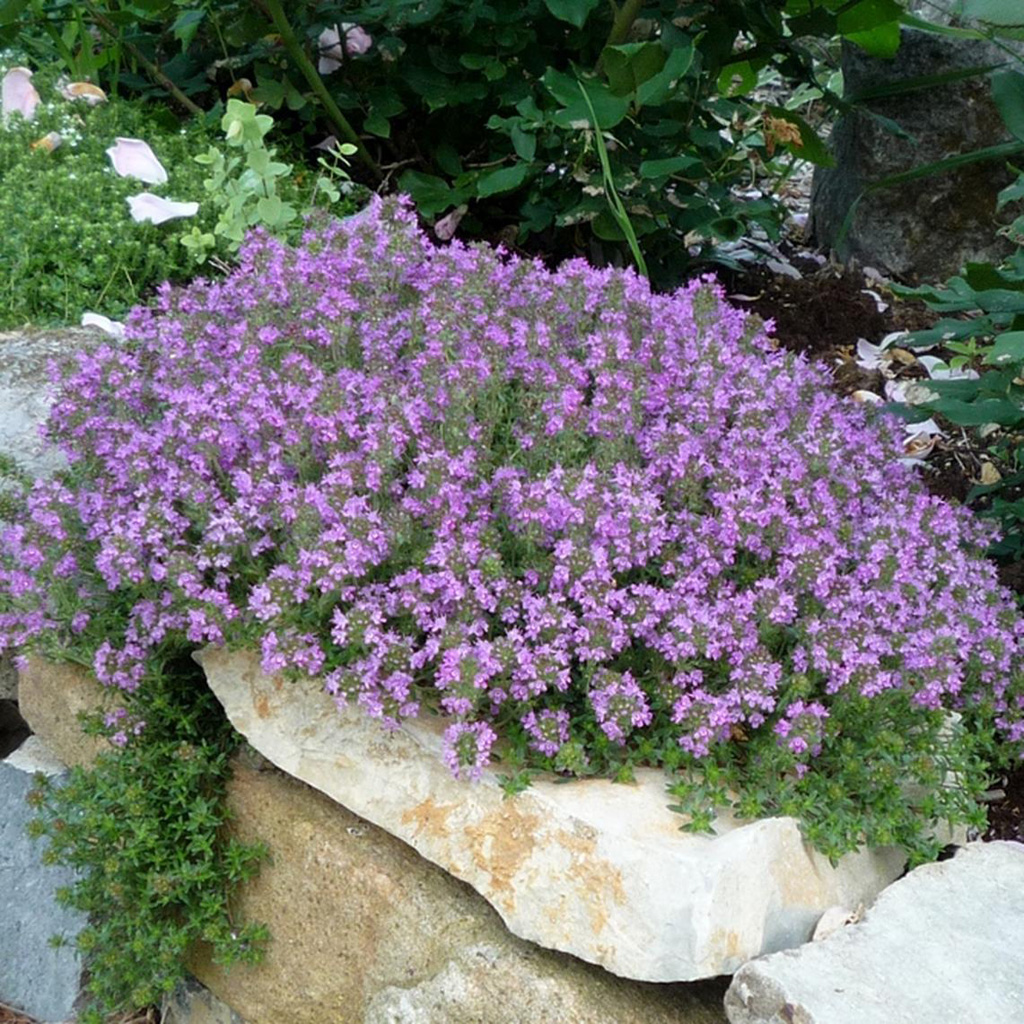

This ground cover is a good choice for encouraging wildlife, for erosion and riparian control, and for rock gardens. They are adaptable to various soils and have a slow to medium growth rate.Ī great feature of bearberry is its evergreen foliage.Ī ground cover I have yet to try, but plan to, is Arctostaphylos uva-ursi ‘Massachusetts’, common name 'Massachusetts' bearberry.They have a mounded to spreading form, and a fine to coarse texture.They will grow to about 2 to 18 inches depending on the species.They also are used in restoration projects.
#PURPLE FLOWERING THYME GROUND COVER FULL#
Sedges grow in full sun but are also good ground covers for shady areas such as under trees and shrubs. One of my favorites is Carex caryophyllea ‘Beatlemania’, common name Beatlemania Spring Sedge or Mop-headed sedge. I have a few ground covers in my yard that have worked out pretty well. But ground covers can also enhance soil health, provide food and habitat for pollinators and other beneficial insects, and reduce soil erosion. I think if you asked most people why we plant ground covers, they would say to reduce weed pressure or to add beauty. Plants grown as ground covers can be ornamental or edible, herbaceous or woody, and perennial, biennial or annual plants. Ground covers can cover an area of your yard or garden for one season (annuals), a few seasons, or many years. It can be a type of mulch, hardscape materials like patio block, or a growing plant. Prune creeping thyme ground cover in the spring to maintain a compact appearance and again after the small, white flowers are spent if additional shaping is preferred.For all the gardeners who are music lovers: 'Beatlemania' spring sedge or mop-headed sedge. Plant creeping thyme 8 to 12 inches (20-30.5 cm.) apart to allow for its spreading habitat. Start seeds when growing creeping thyme indoors or they may be sown in the spring after the danger of frost has passed.

Cuttings from the creeping thyme plant should be taken in the early summer. The soil pH for growing creeping thyme plants should be neutral to slightly alkaline.Ĭreeping thyme ground cover can be propagated via stem cuttings or divisions and, of course, can be purchased from the local nursery as either established plantings or seeds. Soil should be kept moist but not wet, as the growing creeping thyme plant is susceptible to root drowning and edema. Although this ground cover prefers well-drained lightly textured soils, it will grow quite well in less than desirable medium and thrive from full sun to light shade environments.
#PURPLE FLOWERING THYME GROUND COVER HOW TO#
How to Plant Creeping ThymeĪs mentioned, growing creeping thyme is a simple process due to its compatibility in a variety of soils and light exposures. In fact, the pollen from the blooming thyme will flavor the resulting honey. Creeping thyme is also capable of withstanding tromping upon by rambunctious kids (making it kid resistant as well!), which makes it an exceptional planting choice anywhere that has frequent foot traffic.įlowering creeping thyme is very attractive to bees and is a nice addition to a garden focused on honeybees. Harvest creeping thyme in the morning when the essential oils of the plant are at their peak.Īnother creeping thyme fact is despite its enticing odor, growing creeping thyme ground cover is deer resistant, making it an ideal landscape candidate in areas frequented by them. To harvest creeping thyme ground cover, either remove the leaves from the stems or dry them by snipping from the plant and hanging them upside down in a dark, well-aerated area. Just like other thyme varieties, creeping thyme is edible with a flavor and aroma akin to mint when crushed or steeped for teas or tinctures.

serpyllum is another creeping thyme variety. will appear in low, dense mats, which sprawl randomly and quickly fill in areas as a ground cover.

An evergreen with lightly haired foliage, this tiny-growing creeping thyme varietal - rarely over 3 inches or 7.5 cm. Thymus praecox is a low-growing perennial hardy in USDA hardiness zones 4-9 with fairly minimal requirements. Let’s learn more about creeping thyme plant care. It is excellent planted as a lawn substitute or among stepping stones or pavers to create a living patio. Creeping thyme, also known commonly as ‘Mother of Thyme,’ is an easily grown, spreading thyme variety.


 0 kommentar(er)
0 kommentar(er)
